Why should you get into crypto?
It’s true – you can’t really use crypto to buy a coffee or pay for groceries. Some online retailers do accept cryptocurrencies, but not many. Often it’s too difficult to figure out, and just not worth it when there are so many easier payment options available. So, why would a regular person – someone not working in tech or finance, and not interested in any pump-and-dump scams – want to get into crypto anyway?
It might be useful to think of crypto as a kind of company stock: you can’t use it to pay for things in stores, but the owner of the asset profits by receiving interest payments from the investment, or selling at a higher price than purchased.
Consider: Recently, the interest paid by traditional bank savings accounts has gotten absurdly low, with the average around 0.04% APY, and rarely up to 0.10% APY. With inflation, fiat (the government-issued money like the US dollar) is continuously becoming devalued. On the other hand, average stock market return over the last 10 years was almost 14% annually. Cryptocurrencies grew many times more in the past year, even taking into account the considerable ups and downs of the crypto market – almost 400% for Bitcoin, and over 1000% for Ethereum, at time of writing.
As you read through this article, keep in mind that none of this is financial advice. You are the best and only judge of whether crypto investments are right for you. High returns are associated with higher risks. Cryptocurrency prices have very high volatility – they can rise and fall suddenly, and can continue falling for extended periods of time. Growth can resume again after a year, two years, or even five years. Just like with stock, it’s hard to predict crypto prices far ahead.
Given the high volatility of crypto, daily trading on crypto exchanges can be tempting, but it's only possible for those who are prepared to pay significant transaction fees. Some fees collected by service providers are calculated as a percent of the trade amount and can range widely across wallets and exchanges. Other fees are required for the maintenance of the blockhain, don’t depend on amount of transaction, and can rise substantially when the networks are busy. Ethereum gas is an example of the latter.
All of this means that you must keep 2 things in mind:
- Investing in crypto may not make sense at lower amounts, because during times of high network congestion, most of the investment will be eaten up by transaction fees.
- As with any other investment, never invest more than you are prepared to lose. There is no magic button for getting rich fast, and the possibility of high reward always comes with risk.
Advantages of Ethereum over other cryptocurrencies
In the crypto world, there are two main currencies – bitcoin (BTC) and ether (ETH). Bitcoin became the first widely adopted cryptocurrency. It was meant to be used primarily for decentralized payments, but evolved to become a type of digital ‘gold’. While it can still be used for payments, it is now mostly seen as long-term store of value. Many people discovered Bitcoin in 2017, when its price grew 20x in 10 months – from $900 in February to $18,000 in December. During March-April of 2021, Bitcoin experienced another price spike, to an all-time-high of more than $63,000.
Most investors who buy Bitcoin just wait for its price to go up, without using it for anything else. For some, it’s a way to protect their assets from inflation, especially in countries where annual inflation rates are higher than 20%. Others consider Bitcoin to be overvalued, as the cryptocurrency is not backed by anything substantial like gold (although, to be fair, neither is any modern fiat currency). In addition, Bitcoin faces a number of usability challenges, including long transaction times, from a few hours to a few days, and high transaction fees – averaging about $20 per transfer, but going up as high as $60.
Ether (ETH) is a more modern and, in many ways, more advanced cryptocurrency. Ethereum network was launched in 2015, about 6 years after Bitcoin, with an entirely new and different concept – smart contracts. This term refers to self-executing agreements that enable the transfer of value (money, content, property) when certain pre-established conditions are fulfilled by the parties. Smart contract logic is executed automatically, which means neither party can cheat the other. This is why smart contract technology and applications are referred to as “trustless”: no trust is needed between participants, because compliance is automated and transparent.
Smart contracts are important because they provide the basis for various applications, called Dapps, to be built on top of Ethereum. These can be anything from financial services, to games, gambling, and collectibles. Any transactions on Ethereum, including interaction with Dapps, require a fee called “gas”, payable in ETH. Therefore, ether is not just a cryptocurency that can be used for payments on the blockchain, but the fuel that supports Dapp function. Each Dapp can also have its own tokens based on Ethereum, and these coins can appreciate in price independently of ether, especially when the Dapp is popular and has a lot of users.
The most popular Dapps right now are decentralized financial services, also called DeFi. They enable a variety of financial operations, including deposits that pay interest, loans on collateral, arbitrage, insurance, derivatives, and much more. In other words, DeFi is creating an alternative financial system, independent from politics and geographic restrictions, and protected from centralized manipulation or failure.
This is the very purpose of blockchain technology and cryptocurrencies. Since the blockchain is decentralized, immutable, and transparent, it makes fraud and centralized interference impossible. This means that there is no reliance on third parties: no need for the government to print currency, no need for banks to hold assets and approve transfers, no need for regulators to oversee transactions. Cryptocurrency is a self-regulating system. It can’t be sanctioned or shut down, and no one can block your account or freeze your assets. These qualities have already attracted millions of users globally to cryptocurrencies like Ethereum, and their number will continue to grow.
Another advantage of Ethereum is its large, active developer community that continues to improve and expand the network’s capabilities. In December 2020, the first phase of Ethereum 2.0 was launched. This project, which should be completed within the next two years, will make Ethereum faster, easier, and cheaper to use. It will also make the network more sustainable and friendly to the environment, since the Proof of Stake model will not require as much energy expenditure as Proof of Work. (Bitcoin's consensus mechanism is Proof of Work, with no roadmap for transitioning to a different model.) With all these updates, Ethereum 2.0 can begin to support even more Dapps that will build a truly free, decentralized Internet – and, of course, make ether more valuable.
Ethereum’s price hit its all-time-high of over $4,000 in May of 2021 – an increase of more than 5x from its price in January of that year. Recently, Visa announced that it will start settling transactions on Ethereum, and PayPal and Venmo have allowed users to purchase ETH on their platforms for some time. Ethereum adoption is already significant, and growing daily.
MEW wallet app – how your assets are secured
In 2015, when Ethereum first launched, it had to be used through the command line, making it inaccessible unless you were a developer or had at least some understanding of code. MyEtherWallet’s first version was created just a few weeks after Ethereum’s launch, enabling simple, convenient access to the blockchain for millions of users. It’s important to understand that MEW is a client-side, noncustodial interface to the Ethereum blockchain. It’s not an exchange or a bank; MEW doesn’t hold assets and doesn’t sell or buy any currencies. Rather, it’s an instrument for interacting with everything that’s built on Ethereum – similarly to the way the browser gives access to the internet.
Precisely because MEW is an interface and not a centralized service, MEW does not collect any user data and doesn’t have any access to user assets. Your wallet information is saved and encrypted locally on your smartphone. When you create the wallet, you get a recovery phrase of 24 words which is used to generate the wallet keys. It’s very important to keep this phrase written down and hidden in a secure location. Don’t screenshot it, email it to yourself, or put it in cloud storage! The phrase gives direct and immediate access to your assets, and is the only way to restore wallet access if you lose or break your phone. As you create the wallet, you will see multiple alerts and warnings about keeping your phrase secure – don’t ignore them!
You may find out (or already know) that some popular crypto platforms, like Coinbase and Binance, don’t give you a phrase and allow you to restore access with an email link. The difference is: these centralized exchanges hold your assets in their wallets and assign you an account, much like a traditional bank does. While this may seem like an easier way to manage your coins, remember – not your keys, not your crypto. If something happens to the exchange, or the CEO decides to run off with everything, your assets will be gone. On the other hand, MEW wallet is like a safe that no one can ever open unless you give them the key – your phrase.
Get started
The MEW wallet app interface is designed specifically with the mobile experience in mind – clear, uncluttered, everything you need within easy reach. You can navigate between the five main sections of the wallet using the buttons on the bottom of the screen, but in order to really explore the possibilities, first you need to create and back up a wallet.
If you are new to Ethereum, we made a quick and fun introduction featuring our astronaut Peggy – “What is Ethereum? Absolute beginner’s guide.” Watch the comic to find out a little more about the Ethereum blockchain, and then click Create a Wallet. Before generating your wallet, please read through the warnings. Basically: Stay cautious, there are a lot of scammers out there. No one is ever giving away ETH. Never give anyone your phrase. Always double-check that you are sending assets to the correct address – no one can reverse or freeze transactions on the blockchain.
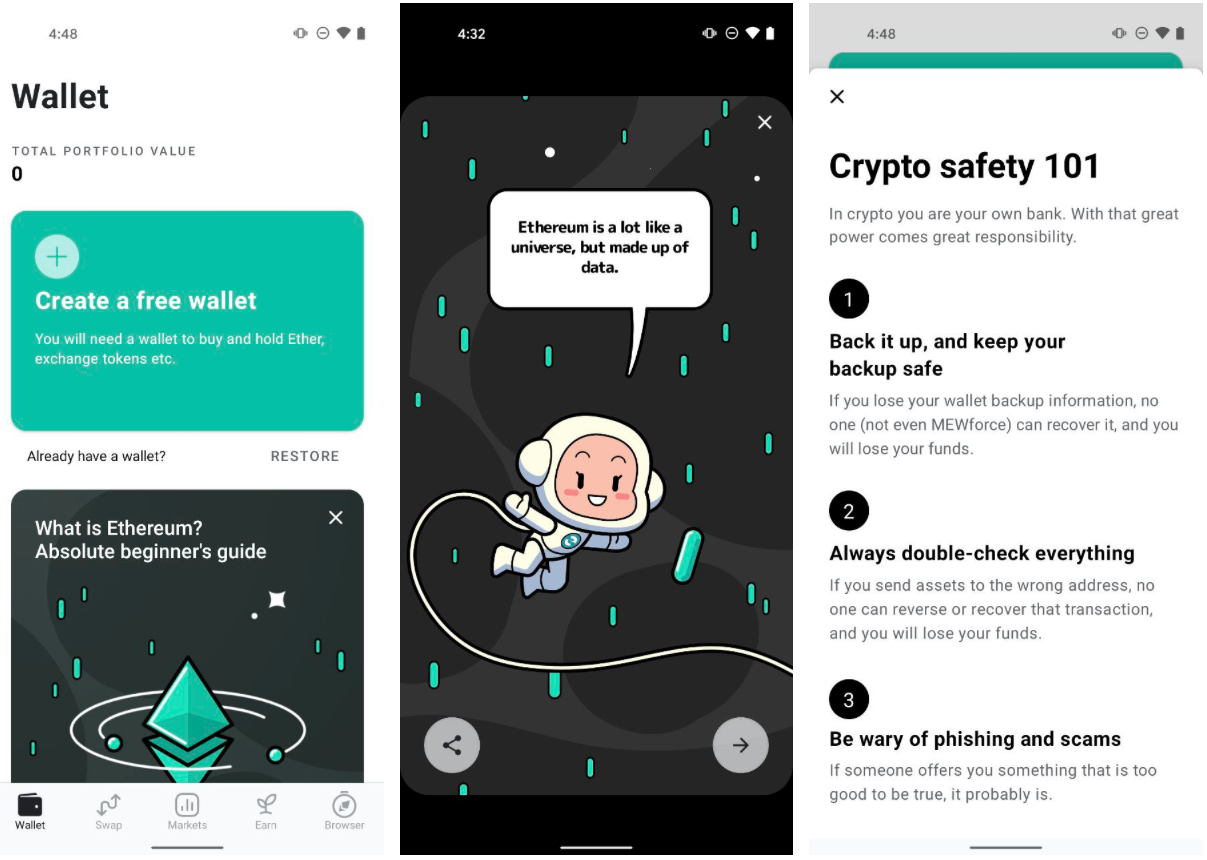
Once you’ve familiarized yourself with crypto’s best practices, go on and create your wallet. Set a good pin code and turn on biometric recognition. You’ll see another reminder to back up your wallet and save your recovery phrase. Click through when you’re ready, and you’ll see a list of 24 words. Write these down very carefully on paper, correctly spelled and in the exact order. Pass a short test to verify that you recorded the phrase, and you’ll be done! The Wallet tab will now show your wallet address, ETH and token balances. You can also create additional accounts with different addresses by swiping right and choosing Add account. Don’t worry, all your accounts are backed up by the same recovery phrase. Now, it’s time to get some crypto!
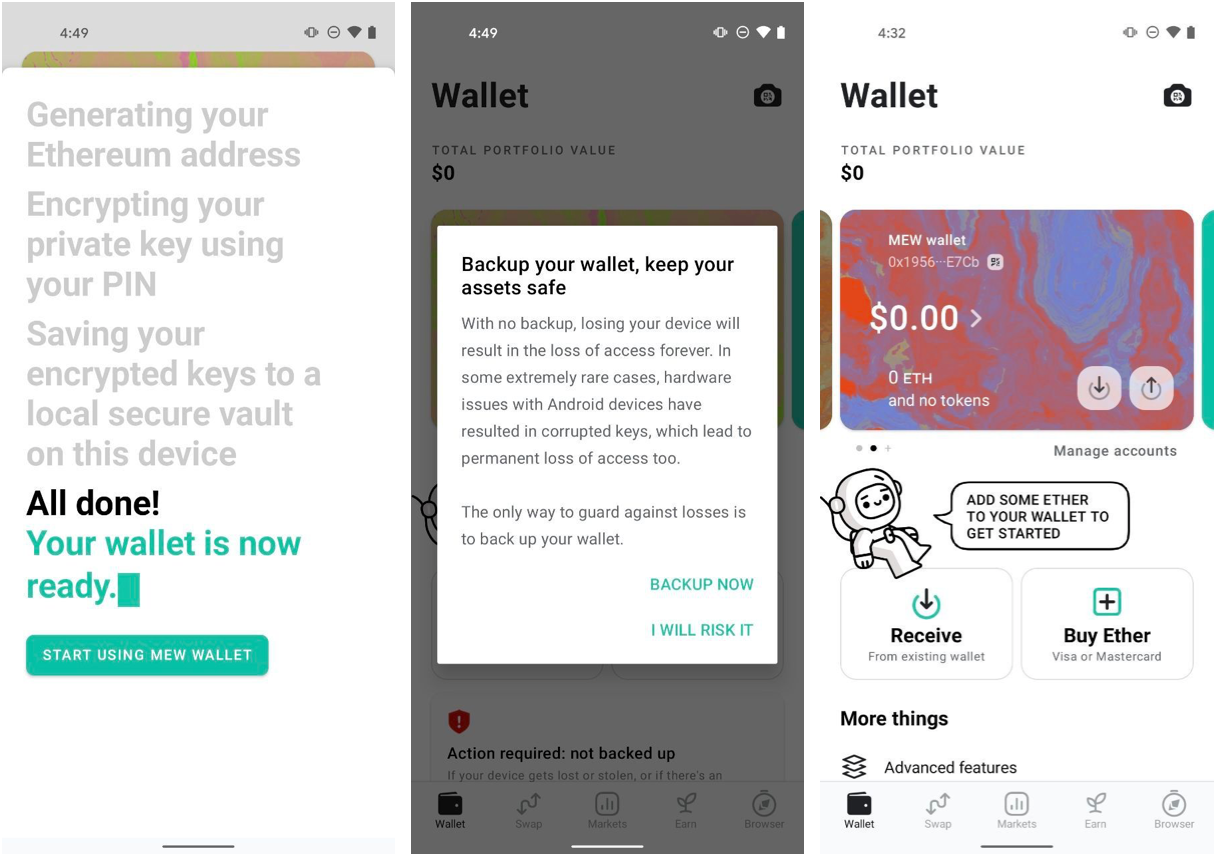
Buy crypto
You can buy ETH in MEW with a credit card, debit card, or ApplePay (if using an iPhone), in multiple world currencies. Depending on your location and device, your ETH purchase will be handled by one of two providers – Simplex or Wyre, two of the largest and most reputable payment systems in the crypto space. In the unlikely event that there is an issue with a purchase, your card will not be charged or the charge will be refunded.
Select your purchase amount from the available presets, from a minimum of $50, or set a custom amount all the way up to $20,000. Then, fill out your card details, as you would for any purchase online, or use ApplePay on iOS for a one-click purchase. A debit card may be a better choice here, since banks may interpret a credit card purchase as a cash advance and charge an additional fee. You can save card information to make future purchases quicker.
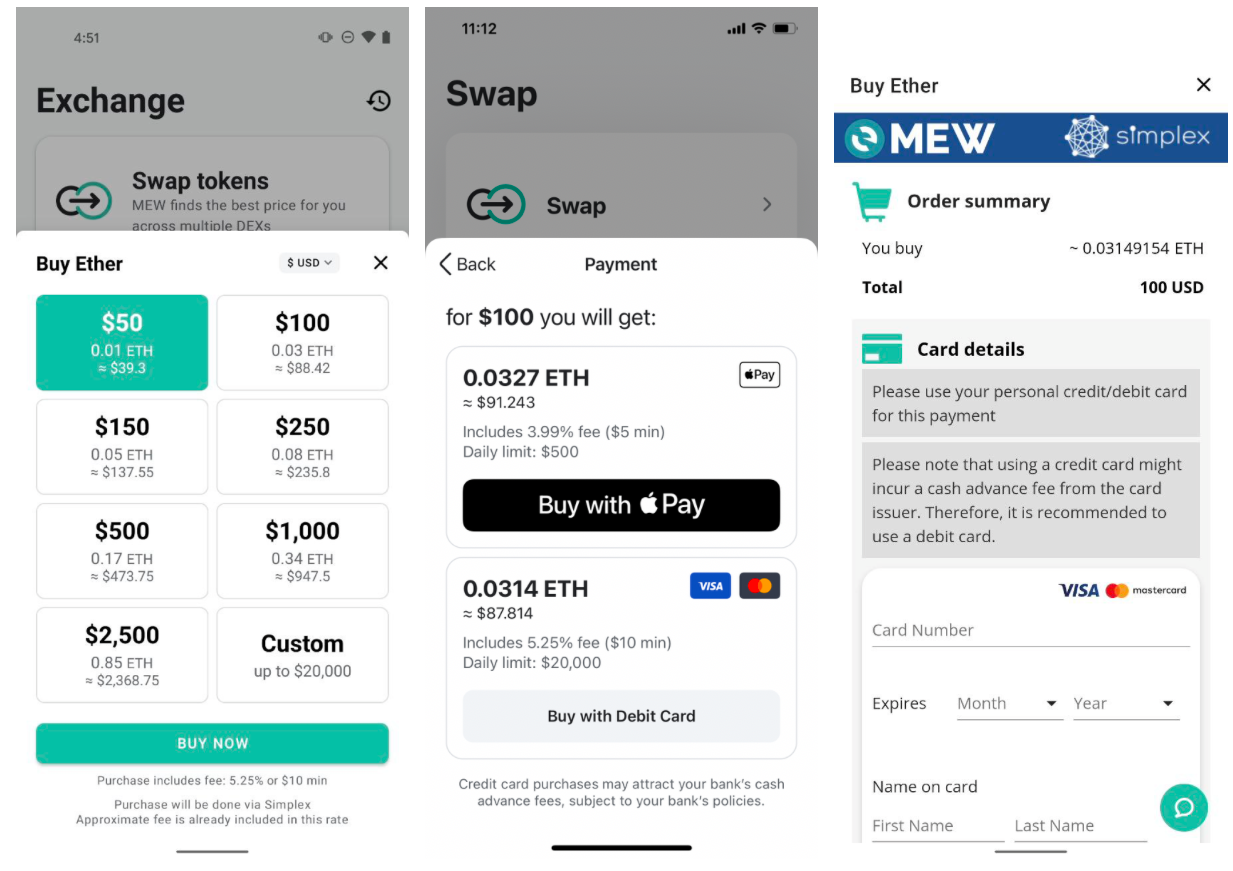
Swap ETH and tokens
In the Swap tab, you’ll be able to swap your ETH for hundreds of tokens. On the blockchain, tokens are like stocks: crypto companies mint their own tokens to reward users, build a community, and attract liquidity. As these tokens are traded on crypto exchanges, their price can rise and fall just like any other asset. Other tokens, called stablecoins, are actually tied to the price of a fiat currency, usually the US dollar, to keep their price stable regardless of market volatility.
In addition to swapping between Ethereum-based assets, you can also Move your Bitcoin to Ethereum in the Swap section (only on iOS). What does this mean? If you already own bitcoin, you can use it to explore Ethereum’s tokens, DeFi, and Dapps without losing the bitcoin’s value. To do this, you put up your bitcoin as collateral to get an Ethereum-based wrapped bitcoin token. The price of this token is tied to bitcoin’s price, so it will grow together with the original asset. Meanwhile, you’ll be able to use it for crypto loans, interest-paying deposits, and Dapps. You can’t do any of these things on the Bitcoin blockchain – there, coins are just held in your wallet until you sell them or send them to someone else. You can get your bitcoin back at any time by returning the wrapped token.
MEW supports two types of wrapped bitcoin – WBTC and renBTC. The latter are tokens of a progressively decentralized project Ren, which means the number of their decentralized nodes is growing, making the project less reliant on any individual node over time. This is one of the main benefits of decentralized systems. No one has the power to make decisions for the entire project in their own self-interest.
Token swaps in MEW are carried out by aggregators of decentralized exchanges 1inch and DEX.AG, as well as the Changelly exchange. The MEW wallet app will find the best price for you, similarly to the way apps like Skyscanner or Kayak find the best airline fares. With MEW wallet and integrated DEXes, you have the complete decentralized, non-custodial solution. You don’t need to upload your ID documents to the exchange (as you would with exchanges like Coinbase or Binance), and your assets always stay in your wallet where you have full control.
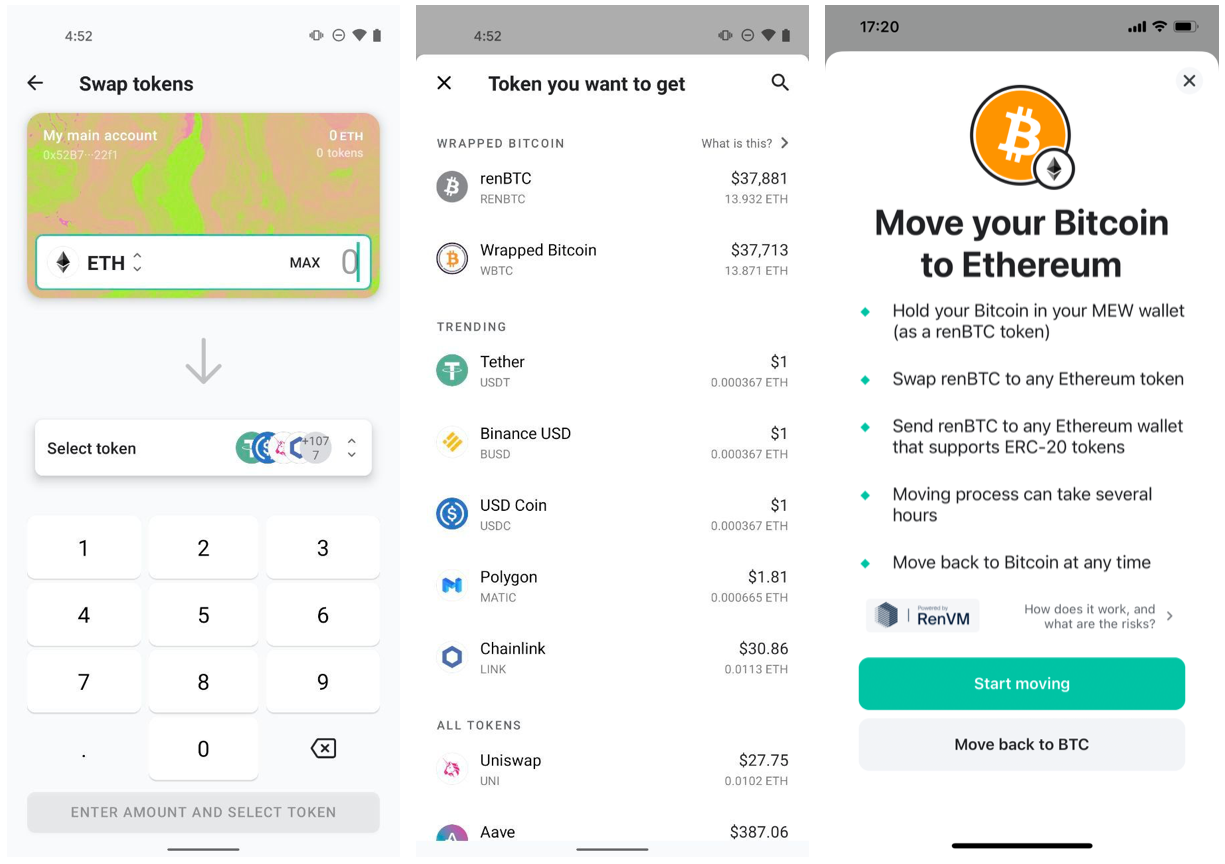
Watch the markets
The Markets tab displays charts of token price movements, highlights the biggest market movers, and features collections of tokens by theme – like DeFi and stablecoins. For example, there are 10 kinds of stablecoins, and while they are all close to $1.00 in price, some of them are less strongly pegged to the dollar than others. In token collections, you can compare the prices and read descriptions of the projects behind the tokens so you can make informed decisions when choosing where to invest.
Under the All tokens tab, you can find a searchable list of all tokens available for swap through MEW. When you tap on the token that interests you, you’ll see price graphs by day, week, month, 3 months, year, and all time, as well as token market cap, circulation supply, 24h volume, and total supply.
For any tokens that you hold in the wallet, you can set up notifications for sudden price changes, so you don’t miss out on the opportunity of buying or selling assets at the optimal time.
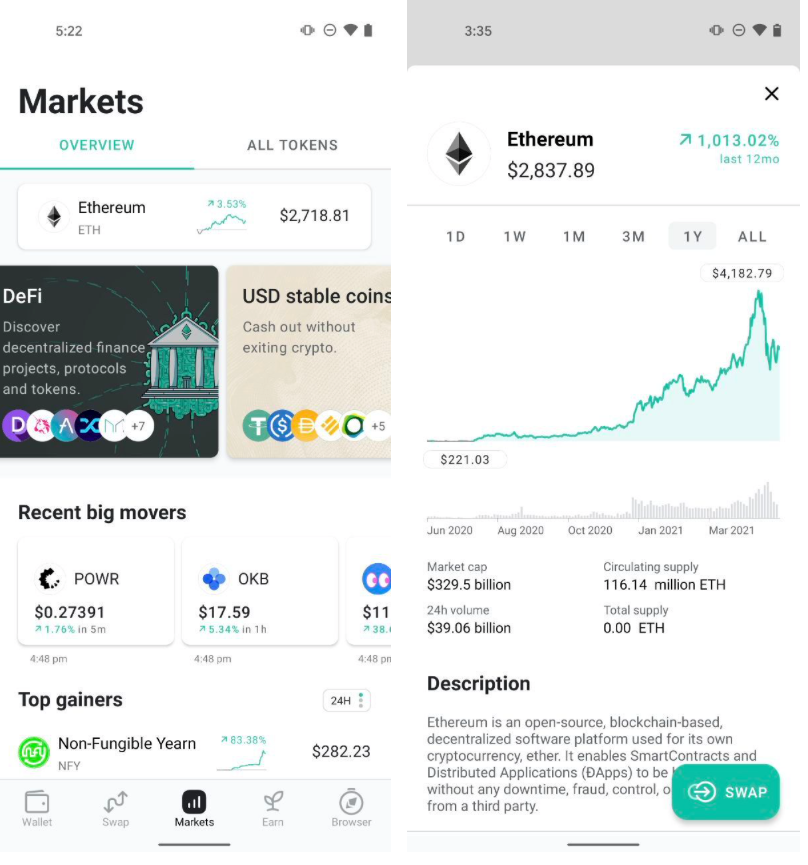
Invest in crypto and earn rewards
The Earn tab features staking on Ethereum 2.0, made available through our partner Staked. Here, you can deposit your ETH and receive interest payments – currently up to 8% APR. However, for now, Eth 2.0 staking is a one way street. Once the ETH is staked, it must remain in the staking contract until transfers are enabled on Ethereum 2.0 at some point in the next few years, so it’s definitely something to consider carefully, especially since 32 ETH need to be staked at once to establish an Eth 2.0 validator.
For faster returns with a smaller commitment, you might explore DeFi tools on Ethereum for crypto borrowing, lending, and pooled staking, both for Ether and other coins. To start, you can use your MEW wallet app to connect with Aave and Maker (integrated in MEW web), but there is a big and quickly expanding world of decentralized apps on Ethereum.
Decentralized apps
In the Browser tab (only on Android), you can interact with an extensive selection of Ethereum Dapps. To help you explore, we’ve selected some Dapps that we think are worth your attention – you will find these in the Featured section. You can mark Dapps as favorites to have them appear in the Favorites section, and Dapps you’ve interacted with will appear in Recents. Clicking on “Discover top Ethereum Dapps” will take you to a Dapp catalogue curated by our partner DappRadar. Browse categories like Exchanges, Collectibles, DeFi, and Games. Opening a Dapp will take you to their web app, where you can connect with your MEW wallet. Keep in mind that all these are third party applications, and MEW is just a way to interact with them.
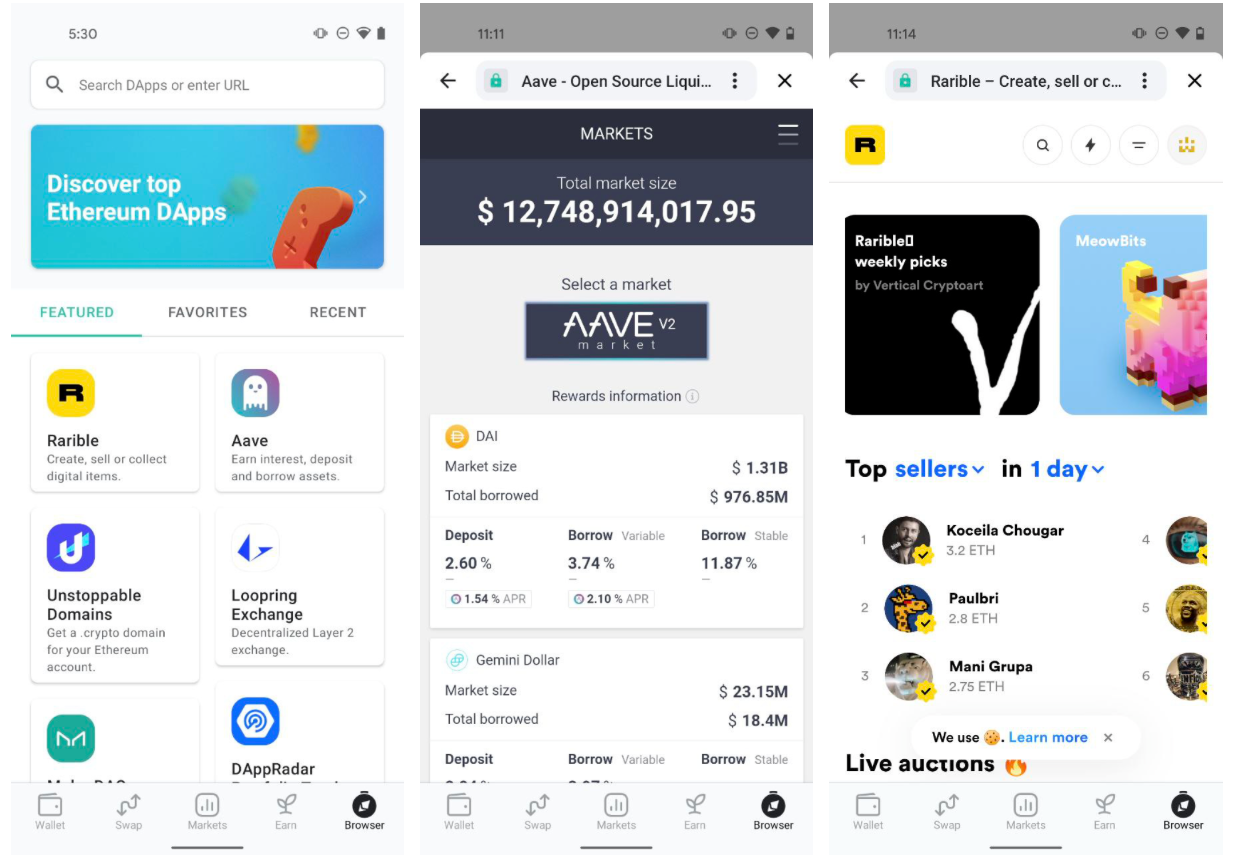
Conclusion
We believe that MEW is the simplest and most intuitive mobile wallet for interacting with Ethereum – the cryptocurrency that is second only to Bitcoin in market cap, and has the most growth potential in the crypto space. MEW wallet aims to make the complex world of crypto accessible to any user, regardless of technical ability. Educational resources and an easy-to-navigate interface will help newbies get started, and experienced users can benefit from advanced features like staking. We hope that MEW helps you get comfortable with the Ethereum blockchain, so you can join the new decentralized financial ecosystem and make it work for you.
Learn more
Before diving into crypto trading, make sure you are aware of these tips: https://www.mewtopia.com/how-to-exchange-crypto-five-things-to-know/
Go into more detail about Ethereum 2.0, staking, and the roadmap for Ethereum network changes: https://www.mewtopia.com/eth2-staking-beacon-chain/

